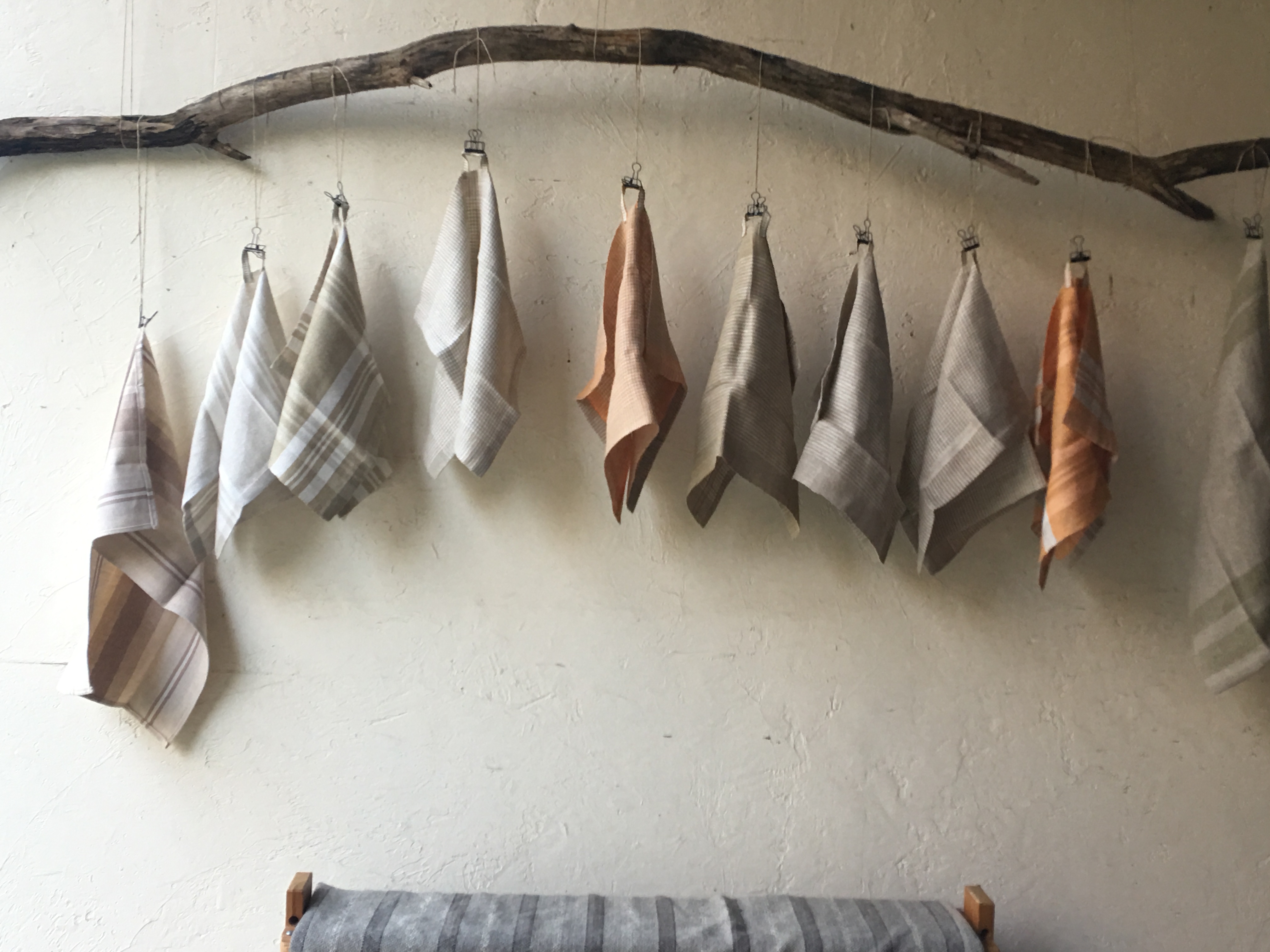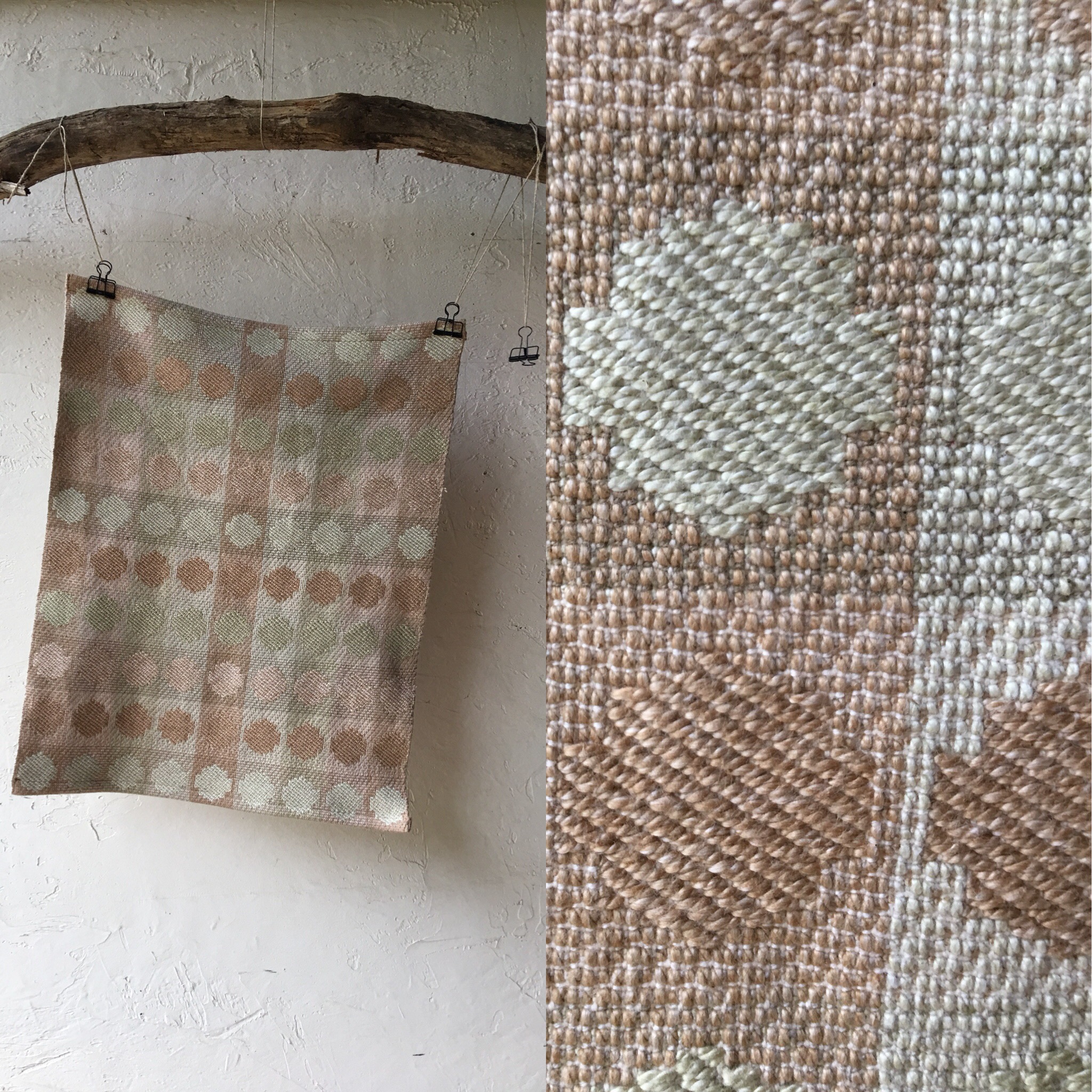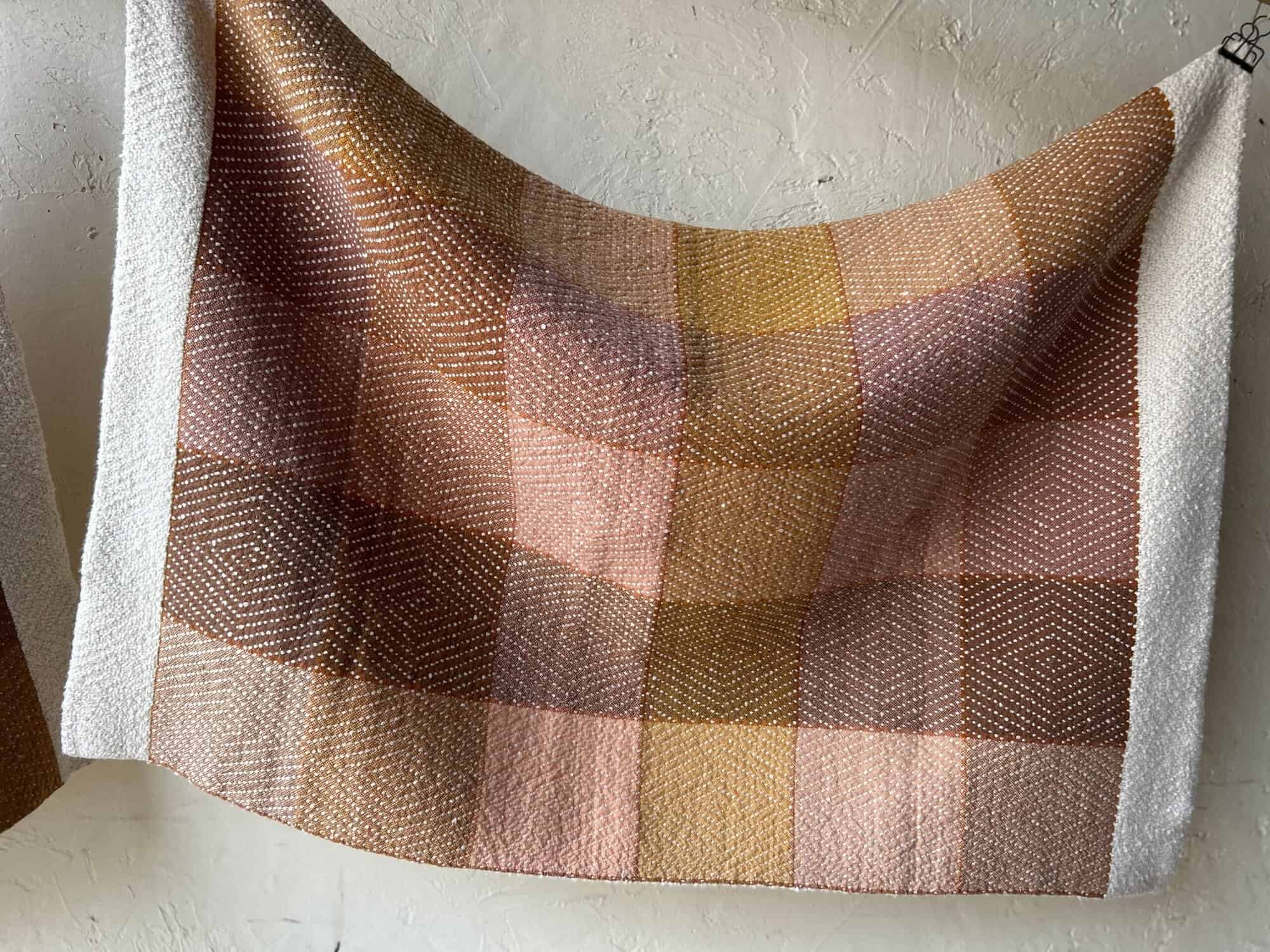Cloth Conversations
 I recently participated in the Working Weavers Studio Trail. I was surprised and pleased that we had a very busy weekend with a non-stop stream of visitors. The majority, I believe were fellow weavers. I really enjoyed the opportunity to set up a display of my work and “talk shop” with weavers from near and far. One conversation I had, however, was a little disconcerting. I quickly forgot, having to prep for a class I was scheduled to teach in Canada (side note: fabulous, fabulous Huronia Weavers Guild!). The conversation came back when I returned from Canada, and had a conversation with another local weavers who repeated the disconcerting sentiment, having apparently spoken to the first weaver about me. So, the theme of the message was that, “I wasn’t a towel weaver.” I was too confused the first time to respond, but after it was repeated to me, I wanted to try to understand what was meant. My response upon hearing it a second time was, “What do you mean? I’m a weaver.” I don’t only weave towels, but I do weave towels, and the whole thing brought up an idea that irks me when I encounter it in my weaving community. That is the impulse to restrict and narrow weaving and to try to impose “a way” when one of the most wonderful aspects of weaving is that there are myriad “ways” in which to be a weaver. My impulse, and I believe our duty as modern hand weavers is to open and broaden the “conversation”, not try to restrict and narrow it in any way.
I recently participated in the Working Weavers Studio Trail. I was surprised and pleased that we had a very busy weekend with a non-stop stream of visitors. The majority, I believe were fellow weavers. I really enjoyed the opportunity to set up a display of my work and “talk shop” with weavers from near and far. One conversation I had, however, was a little disconcerting. I quickly forgot, having to prep for a class I was scheduled to teach in Canada (side note: fabulous, fabulous Huronia Weavers Guild!). The conversation came back when I returned from Canada, and had a conversation with another local weavers who repeated the disconcerting sentiment, having apparently spoken to the first weaver about me. So, the theme of the message was that, “I wasn’t a towel weaver.” I was too confused the first time to respond, but after it was repeated to me, I wanted to try to understand what was meant. My response upon hearing it a second time was, “What do you mean? I’m a weaver.” I don’t only weave towels, but I do weave towels, and the whole thing brought up an idea that irks me when I encounter it in my weaving community. That is the impulse to restrict and narrow weaving and to try to impose “a way” when one of the most wonderful aspects of weaving is that there are myriad “ways” in which to be a weaver. My impulse, and I believe our duty as modern hand weavers is to open and broaden the “conversation”, not try to restrict and narrow it in any way.
This brought up something my son said a few years ago while he was in art school. He said that while an artist/craftsperson must have a strong internal vision/aesthetic, you must also recognize that you are part of a conversation. The conversation is multi-faceted. You are in “conversation” with your materials, your tools, your peers, your predecessors and the swirl of image, color, style that inspire and influence you daily. And just like regular conversation you have to listen, absorb and then speak your mind. Your experience and knowledge makes you a more interesting conversationalist, and having an open and inquiring mind keeps the conversation lively.
This idea reverberated in my mind when I was told that I wasn’t a “towel weaver”. I think I am simply “a weaver”. I weave to explore structure and technique, I weave because an irresistible yarn talks to me, I weave because making and using handwoven items gives me great pleasure, and I weave because I can’t imagine not weaving. And I believe that whether you weave tapestry, rugs, scarves, blankets, yardage or simply weave to weave you are a weaver. If you choose to self identify as a “rug weaver”, “tapestry weaver”, “production weaver” or “towel weaver” . . . absolutely your choice. Open up the conversation folks – don’t impose artificial boundaries on a craft that spans continents, millennia and pretty much every culture. And finally and more importantly, don’t let yourself be boxed in – you are the one putting weft to warp in any style you choose. The two criteria for weaving cloth as far as I’m concerned is that it hold together (if you want it to) and that it be beautiful (if you want it to be) – everything else is up for grabs.
I wrote the above just before taking a class with Suzi Ballenger on “Loom Hacks”, specifically using the rail reed/open-top reed/fan reed and shaped beater to modify your loom. The class was illuminating in many ways that coincided with my blog post, and Suzi’s attitude was inspiring. She not only defies “the grid”, she seems to see any imposition of boundaries in weaving as a personal challenge. I have been a long time fan of defying the grid structurally, but it was eye-opening to see all the ways weavers have conspired to override the restrictions of the loom beyond structure. Suzi made the point that many of these “innovations” aren’t really new. Weavers have always been problem solvers, and solving the problem of the limitations of the loom or grid has been part of weaving forever, whether it be pick-up, hand manipulation, space-age polymers, or loom hacks.
So the title of this post may be Cloth Conversations, but it could well be Breaking Boundaries, Cracking Categories, or Defying Definitions. In any case, the message to myself and anyone interested is that the limitations in weaving are often self imposed, and trying to break out of the limits/constraints of one’s own imagination is hard enough without having limitations/boundaries/categories imposed on you from outside.








Claudia ( teacatweaver)
Thank you so much for this post! I can’t stress enough the truth of your blog. For many years I had self-imposed restricted myself in my weaving because of judgmental encounters. Now I no longer feel pressure to “follow the crowd” or compare my weaving to others. There is too much territory to explore to limit one’s creativity just to fit in. Weaving is such a personal expression. It allows us to embrace our everyday world and give life to what we observe and experience.
Off the grid, on the grid, no judgment! We are weaverrs after all, and weavers bring disparate threads together in their own special harmony.
Elisabeth Hill
Amen Claudia! Thanks for your thoughtful response.
Julia Weldon
Oh, you are so right. Labeling ourselves in any aspect of Life is nothing but limiting. Creativity is limitless. Imagination is limitless. One more possible title to your post: Leaving Limitations
Elisabeth Hill
Yes Julia! Leaving Limitations is a fab addition. Thanks.
marlene toerien
Hi Elisabeth, Claudia said it all. It so wonderful that we do have alternatives to handwoven cloth, so if you want to weave something of beauty with no other purpose than to please the eye, you can, if you want to weave a stack of towels for your kitchen you can! I will never forget the gasp of horror a friend of mine let out when another weaving friend of ours said she is weaving dishcloths to sell at a market. As hand weavers we are only limited by our own choice, and not what others see as weaving.
Elisabeth Hill
Thanks for your comment Marlene. I’m sad but not surprised to hear that other weavers have felt the same pressure to rein in or fit in. It’s ironic to me that there are those among our “bunch of weirdos” (as handweavers kinda are in the modern world) who still feel the need to make one another conform.
Mary Moore
I’ve recently signed up for your newsletter and am a relatively new weaver from England.. Luckily my introduction to the craft was from a wonderful teacher who actively encourages thinking “outside the box” when designing woven pieces. Part of the appeal of weaving, to me, is the endless creative design possibilities. In fact, when I realised that lots of weavers (especially from the US and Canada) spent ages weaving towels I was somewhat perplexed. It seemed such a lot of trouble and expense to go to just to produce something that dries dishes! (Doesn’t mean I wouldn’t be averse to weaving the odd one of two. Happy Weaving!
Elisabeth Hill
Hi Mary,
Thanks for the comment, and it is wonderful to hear that we have a new member of the fold. It is also great to hear that you found an excellent teacher to help you launch. Early support and encouragement really makes a difference. I am still (20 something years on) super grateful to my first teachers for their help and encouragement. Anni Albers wrote about how new weavers are often the most innovative because they haven’t yet learned “the rules” and often don’t know that they have broken them. Weave on!
Amy Norris
Amen! x a squillion!!!
Having just had my annual sale last weekend and selling 98 towels in less than a day….I had occasion to look up how many towels I’ve woven since 1998 when I started selling them. More than 1500, apparently. Who knew?
But that said – I’d be incensed if someone tried to label me a towel weaver. Like you, I’m a weaver. Period.
Elisabeth Hill
Hi Amy,
WOW!! 1500 towels! That is amaaazing . . . and you not a towel weaver😉
Christine
Hope to learn a lot from your site. I am not good with the Internet. Am I automatically signed up for the newsletter?
Elisabeth Hill
Hi Christine,
You are a subscriber – thank you❤️
kim gordon
WOW. This reminds me of one of my first ever weaving guild member encounter when she asked me (a beginner) what I intended to weave. When I told her I wanted to weave linen for yardage for unique clothing, flannel strip rag rugs and other special things for my home, try out patterns on my 4 shaft loom, experiment with acrylic paint on warp and use water colored paper with words and images as weft for one of a kind hand manipulated tapestries…she gave me an incredulous look and shook her head and said something about being overly ambitious. The loom is a wondrous tool, but so are our imaginations and dreams. If someone wants to “specialize”, more power to them. But no one should judge, or be judged on what they wish to weave.
Elisabeth Hill
Hi Kim,
Go girl!!